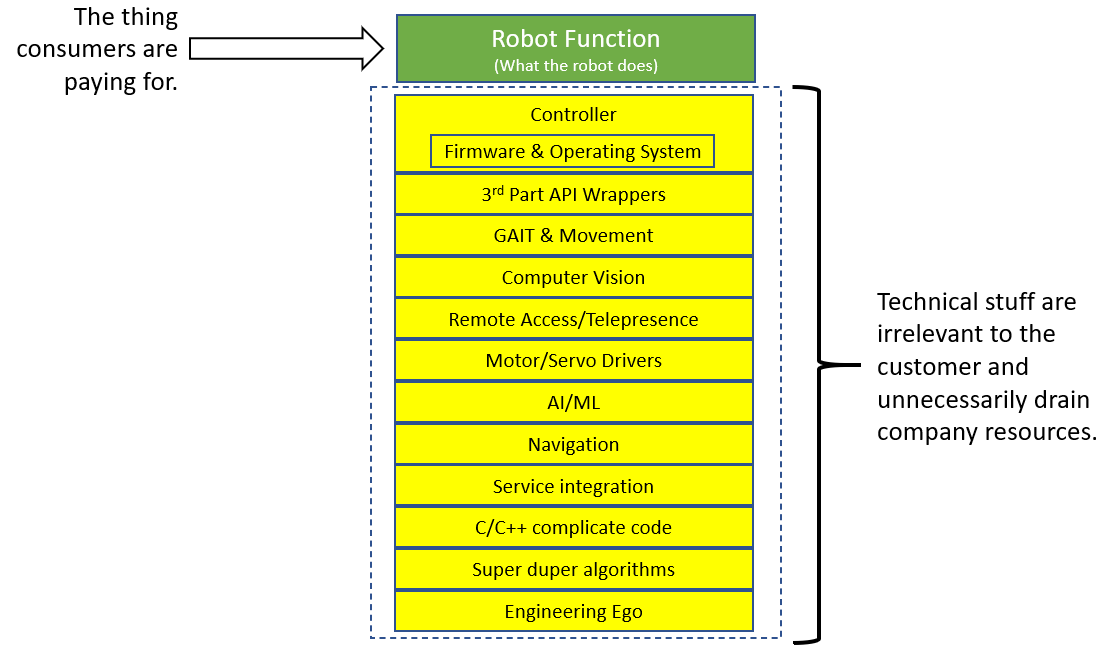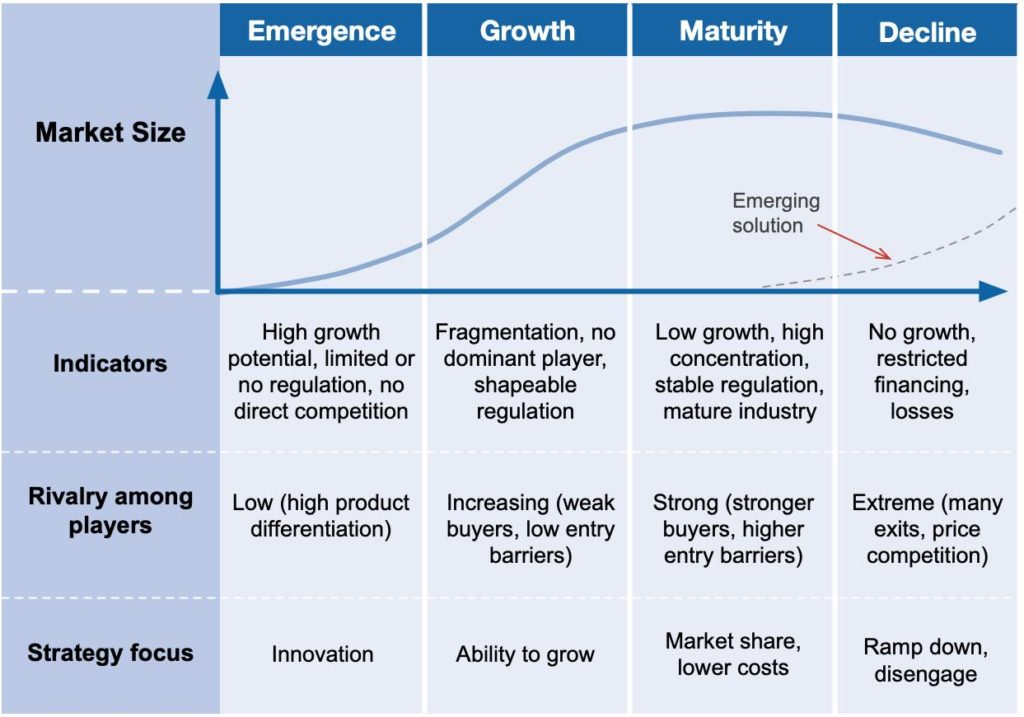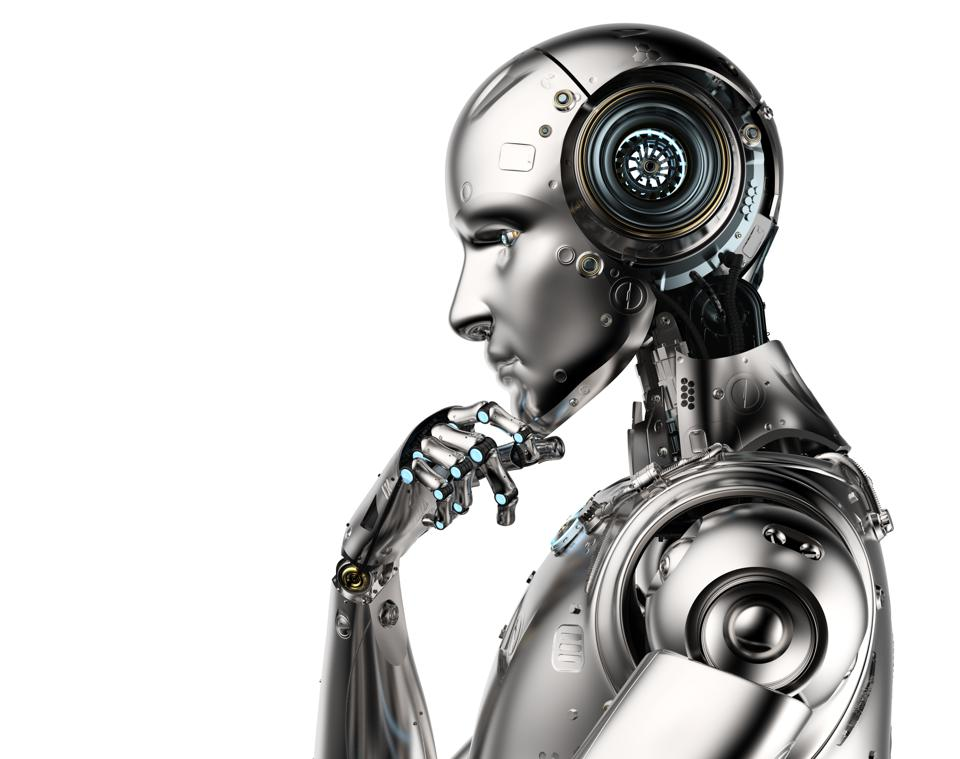
RIP: Anki, Jibo, Baxter, Mayfield, etc...
History foretells the fate of robot companies that attempt the burden of building and sustaining "the full-stack." Similar outcomes have affected companies from all industries where the founding partners were engineers. Today, we begin to ponder the question of where are the robots? Most importantly, why have so many robot companies failed, and what can we do to help robot companies succeed?

Perhaps the noise from social media, politics, and the current Covid-19 situation has caused startups and the investment community to forget a vital part of the industry life cycle stages. Organizations might have also overlooked this because it has also been several years since a new industry has emerged. Even the last few personal-computer sub-industries of mobile devices/apps, VR/AR, etc., have inherited sectors from existing mature and proven industries.

Robotics is a unique industry, albeit not too different from the personal-computer evolution, where multiple disciplines united to form a consumer product. The Personal Computer took many decades to influence and support sub-industries of software, hardware peripherals, and a wide range of use cases. Today, a computing device is user-friendly and esthetically pleasing, and the complex engineering disciplines are well hidden (CPU, operating system, drivers, power management, etc.). Readers may recall early personal-computer diagrams that included input, output, processing, and storage devices. Even earlier than the 1980's personal-computer, a computer consisted of even more complicated engineering disciplines that seemed impossible to scale to what we have today. Today, a computing device is common-place, and the components that make up computing devices are not taught in school as they once were.
The Revolution of Robot Platforms
Today, a child can operate a computing device before knowing how to speak. This results from a mature industry in which every contributor plays their strength by focusing on what they do best when contributing to product development. For example, some profitable companies make integrated circuits with a single function of performing mathematical floating-point calculations incredibly fast; because that is their strength. Another company will manufacturer a button or connector because that is their strength. Again, another produces batteries because it is their strength. The distribution of these disciplines in computing is how organizations can build platforms like Unity, Android, and Wix. Creative entrepreneurs use these platforms to make products that seamlessly integrate with our lives as tools and entertainment. What will it take for the robotics industry to distribute disciplines across specialists and enable creative entrepreneurs to make robot products rather than engineers? Imagine the impact that robot products made by creative entrepreneurs would have on our lives!
So, Where Is My Robot?
 This is the first blog entry in a series titled "Where Is My Robot?". We will cover the robot industry failures, strengths, and areas of improvement needed to fulfill consumer and financial potential. We will reflect on the fallen venture-backed giants that attempted to skip the industry life-cycle steps, such as Baxter, Anki, Jibo, Mayfield, Romo, and many others.
This is the first blog entry in a series titled "Where Is My Robot?". We will cover the robot industry failures, strengths, and areas of improvement needed to fulfill consumer and financial potential. We will reflect on the fallen venture-backed giants that attempted to skip the industry life-cycle steps, such as Baxter, Anki, Jibo, Mayfield, Romo, and many others.
We will examine organizations that repeat Synthiam's message that "too many robot companies focus on the robot and not the business"; however, these same organizations build complex solutions targeted at engineers instead of creative entrepreneurs. In this article by TechCrunch, hardware manufacturers use Synthiam's message that "making robots should be easy" while contrarily designing products targeted at engineers.
In this "Where Is My Robot?" series, other subjects we will discuss are operating system choices that support rapid prototyping for creative entrepreneurs. Most importantly, how using Linux for r&d increases the barrier of entry, adds unneeded operational complexities, and limits productive creativity.
Provide feedback in the comments of topics in this area you would like to see covered. See you in the next blog entry - stay tuned!

I think your first chart at the beginning of the blog hits the nail right on the head. What is the robot's function?
To be successful in the consumer household, the robot needs to be useful and have a good return on investment. Robot vacuums have been very successful because they take on a chore that many people dislike, and automate it. The hours saved by the robot make the cost worth it (much like dishwashers and laundry machines saved time and work that could be better used on leisure activities, or other important chores). One can argue how much of a robot a Roomba or Neato is, but I would argue that they meet most of my needs that I have stated elsewhere for a household robot.
Lawnmower robots have not caught on quite as much yet because the cost is still relatively high, and the initial setup for it to run safely is rather cumbersome. I can hire a guy to mow my lawn for 2 years for the same cost as a robot that will probably last 3 or 4, and need expensive battery replacement every 2.
Other household robots have failed because they didn't add enough value to other less expensive devices that did the same thing. Jibo and Mayfield were somewhat mobile, somewhat interactive versions of Alexa and Google Home. Amazon and Google saturated the market and taught people that they don't really need an expressive face when they can be expressive by voice, and these robots added no other physical abilities.
Baxter came closer since it had an arm and could be taught to do things, but the price was very high, and the level of effort to teach it to do anything was too high.
Anki is an expensive toy. Smarter than most toys, but too expensive for most parents to buy since it is so hard to predict what will interest a kid and make the cost worth it (similar to the Sony Aibo. It could do quite a lot, but cost way too much for most of the public).
If someone builds a robot that can move my clothes from the washer to the dryer, then take them out and fold them, carry them upstairs and put them away, I will spend thousands of dollars for it because of the time it would save me. Even just something that can fold everything would be huge.
Like the vacuums, something to neaten up the house, picking up pet or children's toys and putting them away would be a huge help to many families.
As we add more and more advanced sensor and control capabilities, with appropriate safety measures so they don't accidently hurt the pet they are grooming or the child whose diaper they are changing) there are likely many other uses that could be commercially viable, and would lead to more and more acceptance until we have a roughly humanoid (just because all of our tools, furniture, and houses are human scale) multi-purpose robot that can perform or assist with all household chores including education and childcare, but also putting dishes away, setting the table, cooking or assisting in cooking (there are so many times I would love a sous chef that I could just tell to chop the veggies while I deal with the stove, or vis versa), etc...
That last is I suppose the pie in the sky sci fi version of a household robot, but I think it is really what the public has been taught by TV and movies what to expect from a robot. Until that happens, or we find a way to change the public view so that they understand that many single function robots may be a better solution than one multi-function one, the major adoption of consumer robots will continue to be very slow, and there will be a lot of failures and a few successes along the way.
Alan
Alan, that is exactly what i think. And the one million dollar question is precisely the third point you mention:
So, what is a useful robot? It can be useful for me but not so useful for you. Should it be for the common household or for professional use? What does the current technology allow us to do? Not much im afraid. The key point missing in my perspective is IA. We came a long way in this still emerging field. A robot today as in its primordial days does what it is told to or does it in a random way to simulate awareness, but that awareness that would let the IA know what to do in unexpected situations, or simply knowing how to interact with its environment is not here yet. A robot for the masses today is a toy, an expensive toy that quickly loses the interest of people. So we know what a robot can and cant do, and try to build on that, or have an eureka moment...Here is my 2 cents. Modularity. For a robot to have longevity, it must be modular. This helps reduce the sticker shock to the consumer by introducing a single task in the form of a base unit, but with the ability to scale in the form of upgrades. This will extend the life of a robot and make it cost-effective over time. This is the concept behind Robomodix (MOD in Robomodix stands for modular). You buy Alan, but later want Alena or some other head I have designed, you keep all the mechanics in the neck and head and swap out the front panel, back of head, chest or eyes or skins and tada new robot. Some would say you can only make money in the Iphone "I want a new phone every year" model. I disagree. Let's not waste a robot dumping it in a junkyard at the end of usefulness but rather upgrade it with a new arm model or legs to replace wheels. Modular.
I’m really enjoying this dialog and everyone’s feedback. I had some notes for the next series, and this discussion has tweaked it a bit. I’m excited to write another blog and have more conversations like this!
I find the robot ideas the most intriguing - and comments hinting at shortage of hardware. Specifically with Will’s idea of modular robots.
How many have of you have heard about one of our customers, Sanctuary? They’re founder is Geordie Rose, who created the first Quantum computer. We spent quite a bit of time with them over the last year at our office and theirs. They have a pretty big ambition of making a humanoid robot to replace human labor.
How likely do you feel that will happen? What do you think their biggest challenges are?
Very unlikely. I like mechanically what they are building, but they jumped head first into the uncanny valley. They don't need to look like humans to replace them. No one should be trying to recreate Westworld or Bladerunner robots. They are creating a psychological nightmare for people. If you are trying to replace human jobs with robots that look like humans your not going to win over anyone. All my studies, all my research, all my conversations with Universities that are studying this impact on people, come back to the same square. People will NOT become accepting of these types of robots in the workforce. If a corporation wants to replace 91% of all the workers in a factory, why do they need to look human for the other 9% of human workers still there? There is a misnomer that they will be MORE accepting looking like humans. All they are doing is creating a bigger divide. Its ok for a robot to look "humanoid" (structure of a biped) with two arms two legs and one head. But make it look like a robot.
My philosophy is make robots MOVE naturally, making them look interesting and fun, make them nonthreatening, and don't try and make human looking robots. They fail because in the back of our minds we see millions of humans in our lifetimes, we know how they should look and move and talk, when a robot doesn't move exactly like a human our brains issue a "walking dead" command to our amygdala. Close your eyes and think of Sophia.
Challenges besides the ones stated above...are biped walking. Facial movement that looks absolutely like someone talking. There are 42 muscles to get a face to move, 6 for the mouth. You can't get a robot to make the lip movement of speech without knowing what the robot is going to say first. So if you have 12 sentences the robot will ever say (pre-written) You could spend months animating the lips to move perfectly to that dialog.
BUT, if you have speech synthesis spouting out thousands of unknown phrases you can't predetermine the lip positions for those words (phonemes)...So then you end up with what I did with Alan, which I call "Kermit the frog", where the jaw flaps to the words, but no lip movement. Someone can buy that if it LOOKS like a robot, but try that on a human-robot and the amygdala will throw you into the uncanny valley and then you have a robot that everyone hates....from fear.
I can't agree more about the uncanny valley. Sophia was a really bad robot - and i still don't understand how anyone paid money to see it speak, or why it was on tv. It was a fad that I'm glad is gone. It truly was an unusual phenomenon when we look back and think "why did anyone care about that monstrosity?"
I have to say though, that i really preferred Alan without the silicon skin.
We have to figure out a better mechanical solution - or breed human shells with no brain or soul. And add computers to control the nerves or something. Organic life is still such a mystery to me that it is mind-boggling that my pinky finger can lift more than my robot!
I just watched their videos:
These types of R and D companies are all over Asia. They show you these human-looking robot torsos moving, what you don't see if the enormous compressors used for their pneumatic motion....how the heck is that thing ever going to move about its environment with a compressor tied to its butt? And even if they did and it was all-electric, how long would it be able to work freely (untethered) without a charge up? Spot works for 45 min before needing hours of charging. Explain that to your cooperate investors.
Companies like this will never move forward to achieve their goals in development until technology emerges to resolve all these problems. All these companies do is build these show and tell robots and use words like "replacing humans" and "AI", to get corporate attention for more funding.
..steps down from soap box.....